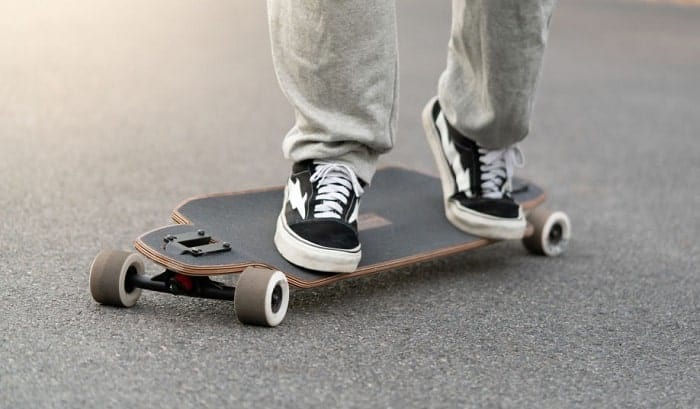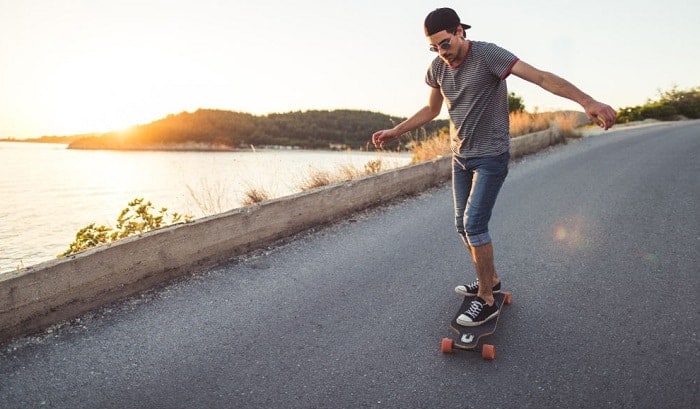Do you want to learn how to ride a longboard like all those cool kids? The first thing you should do, besides reading my guide, is to select a longboard! Skating with a board for the first time is much easier with a longboard, compared to traditional skateboards.
If you wonder why, it is because of its usage of a lengthier deck, larger wheels, and stronger trucks to incorporate a faster and sturdier experience. The most important thing to consider when riding a longboard is to find the pace and position that suits you best.
Table of Contents
What You Need
The Proper Selection of a Longboard
Choosing a board can be a daunting task with so many different variations and features. The key is to find the right longboard to complement your style of skating and personal taste.
The most important thing is to remember that the core of a longboard starts with its deck. The deck is your foundation, and it will dictate how your board feels underfoot and responds to your style.
Two common longboard styles are drop-down and drop-through. The difference between a drop-through and a drop-down deck can be hard to determine at first. It is easier to ride a board when you know its uses.
The drop-down deck is great for precise riding as your body weight is distributed equally between the trucks. For cruisers, drop-through decks are a superior option. Both are easy to manage and maneuver as well.
Protecting Yourself with Safety Gear
To make sure you are able to have a fun and safe ride, use protective gear. Protective gear can include guards that protect your knees, boots or padded shoes, and hard helmets. Longboarding can also damage your board, so if your board has dings, avoid riding it.
A few of the most common injuries for longboard users are to the wrists and hands. Wrist guards and gloves can help prevent this. Skateboarding gloves are an essential piece of protection for your hands while longboarding.
It’s a smart suggestion to use sturdy jeans and jackets to minimize scratches and bruises. Should the sunny conditions prove to be too hot, discard the jeans and the coat, and put on the elbow and knee pads. They are typically ergonomic and budget-friendly.
Instructions on Riding a Longboard
Positioning on a Longboard
Using a longboard is unlike other methods of transportation as it is both environmentally and economically friendly, and it allows you to stay in shape at the same time.
The most important thing to know about riding a longboard is to find out how you should place your feet on the deck. Most people use their right foot for pushing. This depends on the person, so you might want to try boarding yourself on the deck.
To know which foot to use for pushing, you can do simple activities to determine. You can try to play tug-of-war with a friend. Notice carefully how you naturally position your feet when pulling the rope.
Once you figure out how to properly position yourself on the board, it is time to find your balance while the board is stationary. If you can’t balance on a still deck, it will most likely be very difficult to control your board once you are moving properly.
Pushing The Longboard
You’re now ready to begin actually to move on your board. Place the deck on flat pavement, somewhere where there are no cracks or pieces of gravel. Once you’ve learned how to stand on your board, the rest will be much easier.
Place your stabilizing foot on the center of the board. Once one foot is on the board, try pushing with your main accelerating foot. Try to adjust the angle of your feet to at least 45 degrees to the board. This is to optimize your control on the board.
Simple turns are easy to do. If your feet are angled, putting weight on your toes will turn them one way while putting weight on your heels will turn it the other way. The direction will depend on which way you are generally facing the board.
Stop the board
Once you know how to make your board roll, it is also important for you to learn how to get off the deck safely. A simple technique you can do is to use your shoe’s toe or heel area to create friction instead of pushing, to make the board stop slowly.
Reading an article on how to propel yourself forward using a longboard is much easier than the experience itself. Balance remains an important factor in whether you have mastered the art of pushing, turning, and stopping a longboard.
I always advise everyone to stay on the safe side. Even if you have read this portion, nothing beats actual practice and experience. Don’t go overboard until you have enough confidence after multiple sessions of hard work and determination.
Conclusion
It can be very exciting to start your adventure with a longboard, but it is for the best that you never abandon the consideration that you could get hurt anytime and anywhere. With our guide on how to ride a longboard, being prepared for such occasions is the smartest thing a board user can do.
Elbow pads, shoulder pads, and knee pads provide excellent cushioning to your bones in case you fall from the board. Wearing thick clothes is recommended to save you from scratches when you pass by thorny bushes or fall off.
When you are actually starting to travel with a board, make sure to put your feet in the center of the deck. Many professionals like to do stunts by placing their feet on the edge, but this is not something recommended for casual and beginning users.

I am Michael, and I have been enjoying this fun sport for seven years. And nothing is better than having a community to share our passion for those thrilling tricks. I am ready to tell you all I know about skateboarding, showing you how to choose a good board and trick to start and how the practice goes. Stay tuned!




